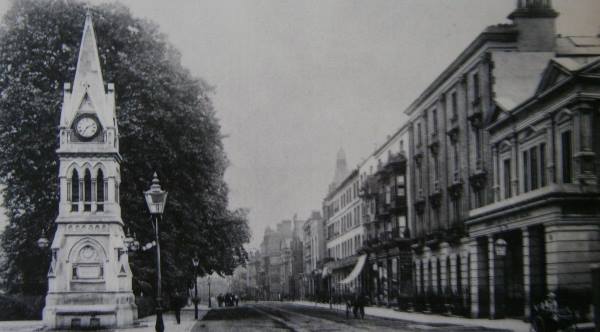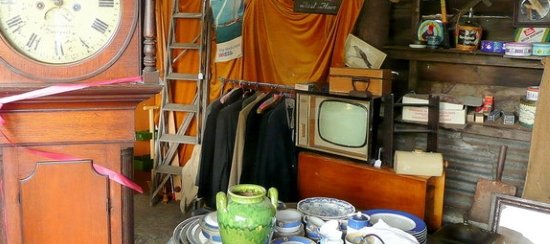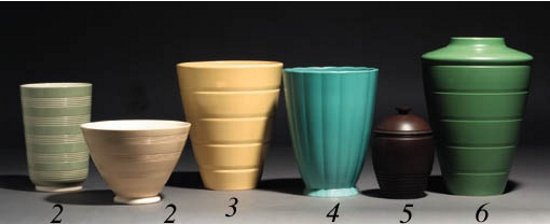There is increasing interest in decorated textiles made or worn by women in colonial Australia. South Australia in particular is a rich source of such material, especially of decorated aprons. These attract considerable interest, not only as examples of the needlework of nineteenth-century women but also as indicators of the social history of middle-class women in rural areas.
In Victorian England, women of the middle and upper classes were trained early in life to dress and behave in a manner that was appropriate to their position in society. For such women, needlework was an acceptable, genteel accomplishment. Decorative black aprons were not mainstream fashion in nineteenth-century England but they were popular with middle-class women: by the 1830s, an embroidered black apron was considered to confer a fashionable aura of gentility upon its wearer.1
An embroidered black apron, made from quality fabrics with expensive silk ribbons and embroidery threads, attested both to a woman’s accomplishments and the affluence of her husband or father. Black embroidered aprons showed who did not do the housework. They were in marked contrast to the white aprons of female servants and thus clearly reinforced female status within the household. Even Queen Victoria, in a painting by A.E. Chalon in 1837-38 [Scottish National Portrait Gallery, Edinburgh], is depicted not as a queen in full regalia, but as a fashionably dressed woman wearing an embroidered, black waist-apron.2
The settlement of South Australia in 1836 occurred under different conditions from that in other Australian states. It was a planned colonisation devised by Edward Wakefield (1796-1862), a British reformer whose idea it was to establish a settlement that reflected British cultural values and was free of convict labour. Consequently, working class men and women were encouraged to emigrate in order to fill positions as labourers and domestics. Policies also encouraged the immigration of a number of yeoman families of various Protestant religions, called collectively ‘Dissenters’.
Middle-class families who emigrated to Australia during the nineteenth century took with them a good supply of clothing (including aprons), their social mores and often their servants; and women expected to resume their previous lifestyle to some degree. However life in rural South Australia for these immigrant families was often quite different to that anticipated. The stringencies of pioneering affected lifestyle. Servants were especially scarce in the countryside as they readily found employment closer to urban centres. Many middle-class, rural women therefore had to ‘make do’ in their own homes and perform multiple duties as milkmaid, cook, housemaid and parlour maid.
Despite the demands of their lifestyle, many of these women made time in which to embroider. Unlike Anglican and Roman Catholic adherents, women in Dissenter denominations rarely made ecclesiastical embroideries. Instead, they concentrated their efforts on items for personal adornment or the decoration of the home. This may be a contributing reason for the quantity of embroidered black aprons in South Australia, as that state had a statistically high proportion of Dissenters in rural areas.3
In England, the fashionable time of the day in which to wear a black apron could dictate its classification as either a morning apron or a tea apron. Although most women in the colonies maintained contact with relations ‘back home’ and were aware of fashionable English customs, slavish adherence to these conventions was not always applicable. In middle-class Australian society decorative black aprons were generally only worn in the best room, called the parlour. The aprons are therefore better known as ‘parlour aprons’.
A number of embroidered, black parlour aprons, many from rural South Australia, are in the collection of Ayers Historic House, Adelaide, run by the National Trust (South Australia). The aprons are in excellent condition, as are the English and German black decorative aprons in the collection of the National Costume Museum at Lobethal, South Australia. This speaks eloquently of the fact that their original owners had less time than anticipated in which to entertain and wear their parlour aprons, many of which remained folded away in the bedroom and were used only occasionally.
It is difficult to accurately date most parlour aprons unless provenance is known. Apron fashions did not change as rapidly as did those of gowns, although an apron had to fit comfortably over the dress worn beneath. Clothing worn by middle-class women in Australian rural areas tended to lag behind European fashions. Many items, including black parlour aprons, were adapted and recycled by adding or subtracting lace, embroidery and other decorations. Moreover embroidery patterns were often borrowed from friends and could be adapted and reused over many years. The colour for the embroidery flosses was a personal choice and subject to varying influences. Every parlour apron was unique.
One silk-lined, black satin waist-apron in the collection of Ayers Historic House is believed to have been brought by its owner from England to South Australia in about the l860s. [Fig. 1] The hand-sewn apron is gored and would fit over the 1860s skirts with their increased volume in the front. The bottom of the apron has a design of ecru braid very carefully twisted and hand-stitched into position. Braid trims around hemlines reflected contemporary English fashions.
Flowers embroidered on black aprons in satin stitch and stem stitch remained popular to varying degrees from 1836 until the end of the century. The most flamboyant parlour aprons appeared in South Australia during the period from 1880 to 1900. Lace was a popular trimming during the 1880s, especially on parlour aprons that featured small bibs. Embroidered floral images became larger and often featured on the bib, pockets and around the bottom edge of the apron. The width of expensive black laces and the brightness of the embroidered bib [Fig. 2], which would be pinned by a piece of jewellery to the bodice of the gown, drew attention to its wearer and represented an eloquent, silent reminder of her taste and of the standing of her family.
The influence of German immigrants on Australian culture in the nineteenth century is of particular interest in the colony of South Australia. Their influence on wine growing in the Barossa region has been well documented, but German women were more influential outside the Barossa area than has been recognised. Many also wore parlour aprons and when they made friends with women from English families, they, on occasion, influenced (and were influenced by) their embroidery designs.
Examples of such cross-cultural exchanges may be seen in some of the parlour aprons of Lucy Barty. Lucy was born of English immigrant parents at Cudlee Creek in South Australia in 1863. She grew up on the family property which was situated on the edges of an area populated by many German families. Lucy’s mother ensured that her daughters were taught the art of embroidery from an early age. Lucy’s sampler, dated 1878, is now in the National Trust’s Highercombe Hotel, Tea Tree Gully, South Australia. [Fig. 3] During the 1880s Lucy also made several lined, entirely hand-sewn parlour aprons using good quality cotton fabric and lace. One of these, dating to about the 1880s, is embroidered in colours that indicate a German, or perhaps an Austrian influence. Indeed an apron of identical pattern (but embroidered with different colours) in the Victoria and Albert Museum, London, formerly believed to be an English design, has been reassessed, on the basis of a comparison with Lucy Barty’s apron, and is now identified as being probably of German origin.4 [Fig. 4]
Another black parlour apron [Fig. 5], made circa 1900 by Lucy before her marriage to Andrew Wakefield, features an embroidered frieze of what may be vine leaves along the hem and across the top of the bib and the pocket. Many German families in her area grew vines and the large wine-producing estate of Highercombe, which had English proprietors, was also well established near her future husband’s property. The vines were a blaze of oranges and yellows in the autumn months and this autumnal colouring is a feature of Lucy’s embroidery on this apron.
Dissenters firmly believed in the Protestant work ethic. Women were expected to work in the home and farm during the week, but the Sabbath was holy and no (male) work was performed. The women however still milked the family cow, prepared the food, and entertained their friends and the preacher in the parlour. This was one day in the week when a woman might proudly wear her parlour apron.
Naturalistic renderings of cottage garden flowers such as roses, jasmine, daisies and forget-me-nots were overwhelmingly popular images to embroider on black parlour aprons. This iconography can be appreciated within the context of the language of flowers so popular during the Victorian era. Roses in particular were favoured as they implied various aspects of affection. The moss rosebud, so prolific on black parlour aprons, signified a confession of love; white daisies symbolised innocence; and forget-me-nots signified true love as well as the obvious meaning. Yellow roses could signify jealousy, and were rarely embroidered on black parlour aprons.
The embroidered designs on parlour aprons in the 1880s were placed around the perimeter of the skirt and on the bib. When the wearer entertained and was seated in the parlour with her apron spread out, it fell to just below her knees, and the embroideries along the skirt edge and on the bib were clearly visible. The act of sitting, and thus drawing attention to the embroidery around the edge of the apron signalled to her peers her skill with a needle. To her servants – if she had any – it was a subtle reminder of status. The apron’s centre was not embroidered, as this area was likely to be hidden by the held teacup and saucer or by an embroidery hoop.
With the scarcity of parlour maids in rural South Australia, young daughters could be pressed into service to hand around the poured teas during these occasions; they were thus educated in social etiquette from an early age. A girl’s black satin parlour apron from the Clare rural district in South Australia, dating from about the 1890s, is unlined, and has a fabric frill instead of expensive lace edging. [Fig. 6] It is embroidered with forget-me-nots and fits an eight-year-old child (by today’s sizes). As children were expected to be seen but not heard, one hopes the girl was not entirely forgotten as she sat in the parlour with her head bent over her small embroidery hoop, listening while her mother entertained.
Most parlour aprons were fully lined to ensure the embroidery was seen to advantage. They should be neither folded down the centre front, nor washed, as this can weaken the fabric. Parlour aprons are now increasingly sought after as collectors’ items; they should be treated with archival care with white cotton gloves being worn when handling and showing them.




